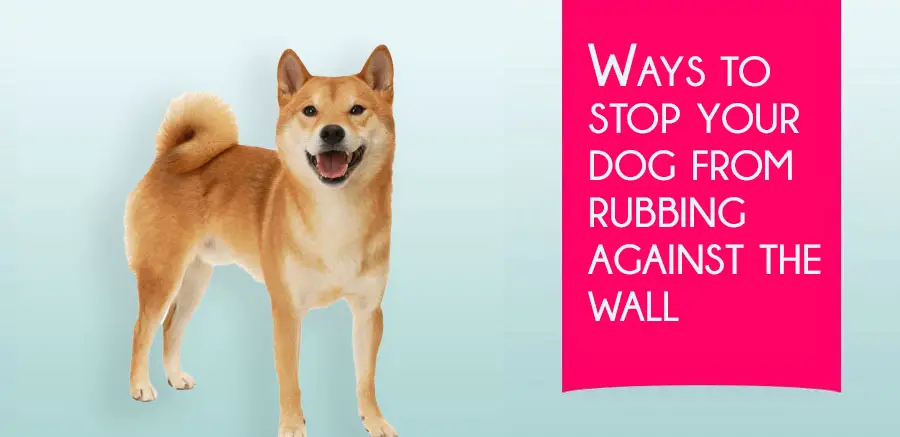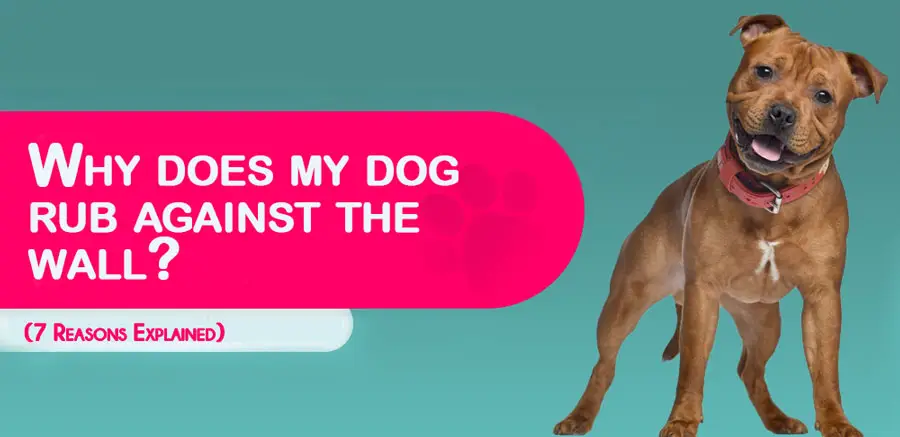Have you ever noticed your dog rub against the wall? This behavior may seem strange, but dogs do it for different reasons.
When dogs rub against the wall, they might be communicating, marking territory, or simply relieving an itch. Regardless of the reason, understanding why your dog does this can give you insights into their behavior and well-being.
In this article, we’ll explore why dogs rub against walls, helping you build a healthier and happier bond with your furry friend while meeting their physical and emotional needs.
Reasons Why Dogs Rub Against The Wall
1. Canine Instinct
Dogs have a unique way of communicating and marking their territory. When your furry friend rubs against a wall, they’re leaving their scent behind, much like signing their name in a language only dogs understand.
This intriguing behavior has roots in their ancestral past as pack animals, inheriting behaviors from their wolf ancestors. Interestingly, it’s male dogs who often take the lead in this territorial marking, like canine graffiti artists.
So, when your dog decorates your walls with their scent, they’re participating in an ancient tradition of communication that links them to their wild ancestors.
2. Attention-Seeking Behavior
Our furry friends love our attention and affection so much that they may rub against walls to get noticed. If your dog sees you react when they do it, like laughing or trying to stop them, they might keep doing it. Playing, training, or giving them toys can satisfy their need for interaction and may reduce wall rubbing.
3. Anxiety Stress
In some cases, wall rubbing can be a sign of anxiety or stress in dogs. Dogs may engage in repetitive behaviors, such as rubbing against walls, as a coping mechanism for their emotional distress.
Your dog displays other signs of anxiety, such excessive barking, pacing, or destructive behavior, it’s crucial to consult with a veterinarian or professional dog trainer to address the underlying cause and provide appropriate support.
4. Marking Territory
One possible reason for a dog rubbing against the wall is to mark their territory. Dogs have scent glands located on various parts of their bodies, including their cheeks, neck, and paws.
By rubbing against surfaces, they leave their scent behind, effectively marking the area their own. This behavior is more commonly observed in intact male dogs, but females and neutered males can also engage in territorial marking.
5. Scratching an Itch
While sensory stimulation plays a significant role in wall rubbing, there may be an underlying itch that drives your dog’s peculiar behavior.
Dogs can suffer from a range of skin conditions, allergies, or parasites like fleas, which can cause intense itching.
When faced with the irritation, dogs instinctively seek relief by rubbing their bodies against any available surface, including walls. Exploring this angle is essential to ensure your dog’s well-being and address any underlying health issues that may be triggering the itch.
6. It’s just soothing!
Dogs, like humans who enjoy massages to relax, can also find comfort in rubbing against walls. It’s like a soothing massage for them, easing muscle tension. Dogs might do this when they’re anxious, stressed, or just want physical contact.
To help your dog, figure out what’s causing their stress and offer them other ways to cope. This can make your pet happier and more relaxed.
7. Habit or play
Sometimes, dogs rub against walls just for fun or out of habit, without any specific reason. It’s part of their interesting and sometimes mysterious behavior.
How to stop dogs from rubbing against the wall

There are several effective methods to discourage dogs from rubbing against walls:
Positive Reinforcement Training
Positive reinforcement is a powerful tool for curbing your dog’s habit of rubbing against walls. This approach focuses on rewarding good behavior rather than punishing unwanted actions.
When your dog refrains from wall rubbing, seize the opportunity to shower them with positivity.
Offer tasty treats, enthusiastic praise, and plenty of affection. This consistent reward system helps your dog understand that avoiding wall rubbing is a commendable action, increasing the likelihood they’ll repeat it.
Provide Adequate Exercise
A key to preventing wall rubbing lies in ensuring your dog stays physically and mentally engaged. Regular exercise and playtime are vital for a healthy, happy pup.
An adequately exercised dog is less inclined to engage in repetitive behaviors like wall rubbing, as they’ll be too content and tired from their activities.
Make it a routine to take your furry friend on stimulating walks, provide interactive toys, and engage in play sessions to keep their mind and body occupied.
Redirect Attention
In moments when you catch your dog rubbing against the wall, swift action is needed to redirect their focus. Gently guide them away from the wall and introduce them to a more suitable behavior or activity.
Offer a favorite toy, initiate a game, or take them for a short walk. By shifting their attention elsewhere, you help break the habit without resorting to negative reinforcement. This positive redirection technique helps your dog understand that there are more enjoyable alternatives to wall rubbing.
Use Deterrents
When trying to deter your dog from wall rubbing, consider employing dog-safe deterrents. These can come in the form of sprays or double-sided tape applied to the areas of the wall your dog frequents.
These deterrents are designed to create an unpleasant texture or taste that dogs dislike, making the wall less appealing. This can effectively discourage the behavior over time as your dog associates wall rubbing with an unpleasant experience.
Environmental Enrichment
Enhancing your dog’s living space is crucial to reducing wall rubbing driven by boredom. Provide a stimulating environment with toys, puzzles, and engaging activities. Puzzle feeders, interactive toys, and regular play sessions can keep your dog mentally and physically occupied, decreasing the temptation to rub against walls out of sheer boredom.
Training and Socialization
Building good behavior through proper training and socialization is key to reducing anxiety-related wall rubbing. A well-trained dog is more likely to exhibit desirable behaviors and less inclined to resort to wall rubbing as a way to cope with stress.
Invest time in obedience training and exposing your dog to various social situations to boost their confidence and emotional well-being.
Adjust Diet
Paying attention to your dog’s diet is crucial for preventing wall rubbing caused by skin irritations or allergies. Ensure their food aligns with their age, breed, and health requirements.
Some dogs may develop itchiness and discomfort due to dietary issues, which can trigger the urge to rub against walls. Consult with your veterinarian to select the most appropriate diet that promotes healthy skin and overall well-being.
Create Safe Zones
Establish designated safe zones within your home where your dog can satisfy their need to scratch or rub. These areas should be equipped with pet-friendly materials or surfaces, like scratching posts or mats, to provide an appropriate outlet for their behavior.
By offering an alternative space for this activity, you protect your walls and discourage them from engaging in wall rubbing elsewhere. This strategy ensures both your dog’s comfort and the preservation of your home.
Consult a Veterinarian
If your dog’s wall rubbing becomes excessive or is a sudden behavior change, it’s advisable to consult a veterinarian. This behavior might signal an underlying medical issue such as allergies, skin irritation, or anxiety. A veterinarian can conduct a thorough examination and recommend appropriate treatments or interventions to address the root cause of the behavior, ensuring your dog’s well-being and comfort.
How to clean stain from dog rubbing against your wall
While your dog’s wall rubbing behavior may seem harmless at first, it can lead to stains on your walls over time. Oils from their fur and outdoor elements can leave unsightly patches. If your dog frequently rubs against walls, here’s how to clean and prevent stains:
First, gather supplies
To clean a wall stain caused by your dog’s rubbing, gather supplies such as:
- Mild dish soap
- Soft cloth
- Warm water
- Bucket
- Old towels (optional)
- Soft-bristle brush
Assess the stain’s severity: fresher stains are easier to clean. Prepare by removing loose dirt with a dry cloth or soft brush.
Create a cleaning solution; by mixing warm water with a few drops of mild dish soap (avoid harsh chemicals). This will serve most of your cleaning needs. However, always test this solution on a small, hidden spot before proceeding.
Cleaning: To clean, dip the cloth or sponge in the soapy water, gently blot the stain (avoid vigorous scrubbing), and repeat if necessary. Rinse with a damp cloth, pat dry, and ensure the area is completely dry. Inspect for stain removal; if necessary, repeat the process. Finish by letting the wall air dry.
Finally, Prevent Future Stains! Consider adjusting furniture placement or training your dog. Always prioritize pet safety and wall integrity when choosing cleaning products. Consult professionals if the stain persists or if you’re uncertain about DIY cleaning.
Summary: Why does my dog rub against the wall
Dogs rub against walls for various reasons, including scratching, scent marking, cleaning, seeking attention, discomfort relief, or even out of habit. Understanding these motivations can help you better care for your furry companion and address any underlying issues they may have.
Why does my dog rub against the wall after eating?
When your dog rubs against the wall after a meal, it’s likely a natural instinct inherited from their wild ancestors. They might be trying to clean themselves or remove food smells to avoid attracting predators.
However, it could also be a sign of allergies, skin irritation, or discomfort. If this behavior continues or if you notice skin issues, consult your vet for a thorough check-up.
Why does my dog rub against the wall after a bath?
After a bath, dogs often feel the need to dry off and remove that “wet dog” scent. Wall rubbing might be their way of achieving this. It can also serve as a fun way to shake off excess water. It’s typically nothing to worry about, but ensure your dog is dry and comfortable after their bath.


